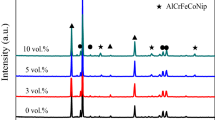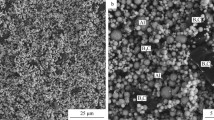The functionally gradient material (FGM), consisting of pure Al outer layer and Al–B4C inner layer, was fabricated by semi-continuous casting with subsequent hot rolling. B4C particles of four different sizes (11, 26, 53, and 75 μm) were used as the reinforcement phase. The effect of B4C size on the microstructure and mechanical properties of the FGM composites was analyzed. Obtained results show that the B4C particles are uniformly distributed in the inner layer. With the increase of B4C particle size, the Brinell hardness of these FGMs increases, but the impact properties decrease.






Similar content being viewed by others
References
Y.J. Xu, Q.Z. Yang, and S. Liu, “Influence of porosity on deflection of FGM thin plate under different environmental temperature,” J. Yantai University, 31, No. 1, 83–89 (2018).
K. Tsuda, A. Ikegaya, K. Isobe, N. Kitagawa, and T. Nomura, “Development of functionally graded sintered hard materials,” Powder Metallurgy, 39, No. 4, 296–300 (2013).
A. Kawasaki and R. Watanabe, “Concept and p/m fabrication of functionally gradient materials,” Ceramics Int., 23, No. 1, 73–83 (1997).
A. Neubrand, R. Jedamzik, and J. Rödel, “Functionally graded materials by electrochemical modification of porous preforms,” Functionally Graded Mater., 233–238 (1997).
X. Rong, J. Chen, J.T. Li, J. Zhuang, and X.J. Ning, “Structural stability and mechanical property of ni(111)–graphene–Ni(111) layered composite: a first-principles study,” Jap. J. Applied Physics, 54, No. 12, 125503 (2015).
T. Tanaka, S. Nishimoto, Y. Kameshima, J. Matsukawa, Y. Fujita, and Y. Takaguchi, “A novel nanocomposite material prepared by intercalating photoresponsive dendrimers into a layered double hydroxide,” J. Solid State Chemistry, 183, No. 2, 479–484 (2010).
L. Yan, H. Kong, and Z.J. Li, “Synthesis and supercapacitor property of three-dimensional graphene/Ni–Al layered double hydroxide composite,” Acta Chimica Sinica, 71, 822–828 (2013).
E. Balci, B. Sarikan, M. Übeyli, N. Camuscu, and R.O. Yildirim, “On the ballistic performance of the AA7075 based functionally graded material with boron carbide reinforcement,” Kovove Mater., 51, No. 4, 257–262 (2013).
Z. Peng and L. Fuguo, “Effects of particle clustering on the flow behavior of SiC particle reinforced Al metal matrix composites,” Rare Metal Mater. Eng., 39, No. 9, 1525–1531 (2010).
H. Zhang, K.T. Ramesh, and E.S.C. Chin, “High strain rate response of aluminum 6092/B4C composites,” Mater. Sci. & Eng. A (Structural Materials, Properties, Microstructure and Processing),384, No. 1–2, 26–34 (2004).
M. Alizadeh, M.H. Paydar, and F.S. Jazi, “Structural evaluation and mechanical properties of nanostructured Al/B4C composite fabricated by ARB process,” Composites Part B: Eng., 44, No. 1, 339–343 (2013).
V.K. Lindroos and M.J. Talvitie, “Recent advances in metal matrix composites,” J. Mater. Proc. Technol., 53, No. 1–2, 273–284 (1995).
J.W. Kaczmar, K. Pietrzak, and W. Wlosinski, “The production and application of metal matrix composite materials,” J. Mater. Proc. Technol.106, No. 1–3, 58–67 (2000).
W.C. Harrigan Jr, “Commercial processing of metal matrix composites,” Mater. Sci. Eng.: A, 244, No. 1, 75–79 (1998).
L. Yadav and S. Dondapati, “Effect of calcium on mechanical and tribological properties of Mg–Sn alloy system fabricated by powder metallurgy (pm) process,” Mater. Today: Proceedings, 5, No. 2, 3735–3744 (2018).
D.L. Davidson, “Tensile deformation and fracture toughness of 2014 + 15 vol. pct SiC particulate composite,” Metal. Trans. A (Physical Metal. Mater. Sci.), 22, No. 1, 113–123 (1991).
Acknowledgements
This work was supported by the “National Natural Science Foundation of China” (Nos. 51501027, 51270142 and 51605067).
Author information
Authors and Affiliations
Corresponding author
Additional information
Published in Poroshkova Metallurgiya, Vol. 58, Nos. 11–12 (530), pp. 147–153, 2019.
Rights and permissions
About this article
Cite this article
Yu, Y., Yao, C., Zhang, Y. et al. Effect of B4C Particle Size on the Properties of Al/(Al–B4C)/Al Functionally Gradient Material. Powder Metall Met Ceram 58, 737–742 (2020). https://doi.org/10.1007/s11106-020-00131-y
Received:
Published:
Issue Date:
DOI: https://doi.org/10.1007/s11106-020-00131-y




